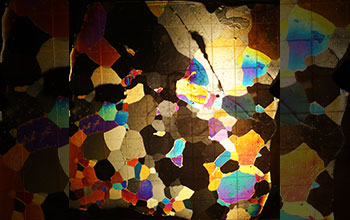Multimedia Gallery
Studying glacial sliding related to rising sea levels
Researchers at Iowa State University (ISU) use cross-polarized lenses to examine thin, horizontal sections of ice. Here, the black colors tell them when they're looking down an axis of the ice grains and helps them to understand deformation in the ice.
Lucas Zoet, a postdoctoral research associate, and Neal Iverson, a professor of geological and atmospheric sciences, are using the newly constructed ISU sliding simulator, developed with support from the National Science Foundation (NSF), to study glacier sliding.
Data collected by the researchers show that resistance to glacier sliding--the drag that the bed exerts on the ice--can decrease in response to increasing sliding speed. This decrease in drag with increasing speed, although predicted by some theoreticians as long as 45 years ago, is the opposite of what is usually assumed in mathematical models of the flow of ice sheets. These are the first empirical results demonstrating that as ice slides at an increasing speed--perhaps in response to changing weather or climate--the bed can become slipperier, which could promote still faster glacier flow.
Understanding how glaciers slide across their beds could help researchers predict how glaciers will react to climate change, and how this will contribute to rising sea levels.
NSF funded both the construction and operation of the sliding simulator through grants ANT 06-18747 and EAR 10-23586. (Date of Image: 2013)
Credit: Lucas Zoet
Images and other media in the National Science Foundation Multimedia Gallery are available for use in print and electronic material by NSF employees, members of the media, university staff, teachers and the general public. All media in the gallery are intended for personal, educational and nonprofit/non-commercial use only.
Images credited to the National Science Foundation, a federal agency, are in the public domain. The images were created by employees of the United States Government as part of their official duties or prepared by contractors as "works for hire" for NSF. You may freely use NSF-credited images and, at your discretion, credit NSF with a "Courtesy: National Science Foundation" notation.
Additional information about general usage can be found in Conditions.
Also Available:
Download the high-resolution JPG version of the image. (2.9 MB)
Use your mouse to right-click (Mac users may need to Ctrl-click) the link above and choose the option that will save the file or target to your computer.



